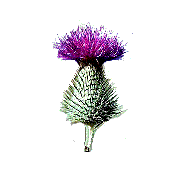 |
Dump the Bull Thistle Campaign |
"Dump the Bull!"....Thistle, that is
 |
Dump the Bull Thistle Campaign |
"Dump the Bull!"....Thistle, that is
According to the legend, Chenango County was named after the Native American term for the area; "The Land of the Bull Thistle", and so the bull thistle has been adopted as the official county flower.
Having struggled with bull thistles in our gardens and fields, we have trouble understanding why anyone would honor this noxious weed, when there are so many other native plants to choose from. Besides having an attractive flower, it seems to have no other redeeming value. So, we decided to do some research and find out the facts.
Bull thistles (Cirsium Vulgare, also known as: spear thistle, Scotch thistle, black thistle, plume thistle) can be found along roadsides, in grassy areas, open fields, pastures, and in our gardens. Bull thistles are a biennial plant which produce millions of wind-dispersed seed. The seeds that don't sprout, can lie dormant in the soil for years waiting for the land to be disturbed, and so infestations persist. Allowing the flower to turn purple before cutting it off, was a terrible mistake, as the seeds will continue to ripen. If the heads have turned purple, they should be cut off, placed in bags and burned.
It has assumed pest proportions throughout the world including the USA, Canada, Argentina, Hawaii, Australia, New Zealand and South Africa. Eradication is virtually impossible. The best way to keep it under control is to keep it cut off so it won't flower. Being a biennial, it will die after the second year. That, however doesn't deal with the seeds just waiting for an opportunity to grow, possibly go unnoticed, and so re-infect the area.
We did find one beneficial use for the bull thistle, some use Bull Thistle Essence as a Medicinal Herb for certain fears and psychological problems. Apparently, one would have to be out of their mind to have a use the bull thistle, how ironic!
It turns out that the bull thistle is indigenous to Europe. It was brought over by early settlers, either accidently, or because of it's flower, which villagers found attractive and easy to grow. Once established, the plant spread widely throughout the Colonies. Instead of "Land of the Bull thistle" One could imagine someone using a similar sounding phrase "Damn the bull thistle!" after coming across the prickly weed with bare legs or feet, that has likely happemed to many of us.
A local Native American Historian who has explored this very issue, has come to the same conclusion.The word Chenango (In various spellings when written down) can have several translations, none coming up as "Land of the Bull Thistle".
Searching for a literal translation of "Chenango" she has come up with 2 possibilities:
(a) "The place of the fern brake".The Fern Brake or Braken Fern is common to the woodlands throughout this area, and certainly describes many of the forests I have walked through.
(b) "The place of the bulrush" Bulrushes look similar to and can easily be confused with cattails. In North America, it is the name often given by some people to the common or broad-leaved cattail. They are abundant around the edges of most bodies of water, and the name could have been mistaken for bull thistle, and passed on in stories.
We believe these facts show that the Native Americans could not have called this area "Land of the Bull Thistle" before the Europeans came. The term likely was created by settlers, and then attributed to the natives.
Although there are organized campaigns in many states to eradicate, or at least contain the spread, of the bull thistle, we can all fight our own individual battles with Cirsium vulgare. However, regardless of it's supposed namesake, Chenango County needs to discard the bull thistle! There are so many real native flowers more appropriate to be the Official Chenango County Flower, than this Johnny-come-lately weed.
We are in favor of a "Dumping the Bull....Thistle, that is", and selecting a flower that is truly native to our land. How do other residents of Chenango County feel about the subject? Should the official county flower be changed? To what? If a majority wants a change, how can that be done, and Who is responsible for making the change? Click on the link below to give your opinion
This website is admittedly biased in favor of a change, but all opinions will be allowed, There will be no censorship of dissenting views, as long as they are respectful.
|
More about Invasive Species Some Opinion Some Nominations for Chenango County Flower |